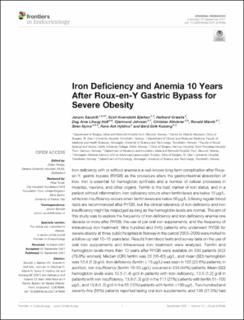| dc.description.abstract | Iron deficiency with or without anemia is a well-known long-term complication after Roux-en-Y, gastric bypass (RYGB) as the procedure alters the gastrointestinal absorption of iron. Iron is essential for hemoglobin synthesis and a number of cellular processes in muscles, neurons, and other organs. Ferritin is the best marker of iron status, and in a patient without inflammation, iron deficiency occurs when ferritin levels are below 15 µg/L, while iron insufficiency occurs when ferritin levels are below 50 µg/L. Lifelong regular blood tests are recommended after RYGB, but the clinical relevance of iron deficiency and iron insufficiency might be misjudged as long as the hemoglobin levels are normal. The aim of this study was to explore the frequency of iron deficiency and iron deficiency anemia one decade or more after RYGB, the use of per oral iron supplements, and the frequency of intravenous iron treatment. Nine hundred and thirty patients who underwent RYGB for severe obesity at three public hospitals in Norway in the period 2003–2009 were invited to a follow-up visit 10–15 years later. Results from blood tests and survey data on the use of oral iron supplements and intravenous iron treatment were analyzed. Ferritin and hemoglobin levels more than 10 years after RYGB were available on 530 patients [423 (79.8%) women]. Median (IQR) ferritin was 33 (16–63) µg/L, and mean (SD) hemoglobin was 13.4 (1.3) g/dl. Iron deficiency (ferritin ≤ 15 µg/L) was seen in 125 (23.6%) patients; in addition, iron insufficiency (ferritin 16–50 µg/L) occurred in 233 (44%) patients. Mean (SD) hemoglobin levels were 12.5 (1.4) g/dl in patients with iron deficiency, 13.5 (1.2) g/dl in patients with iron insufficiency, 13.8 (1.3) g/dl in the 111 (21%) patients with ferritin 51–100 µg/L, and 13.8 (1.2) g/dl in the 55 (10%) patients with ferritin >100 µg/L. Two hundred and seventy-five (56%) patients reported taking oral iron supplements, and 138 (27.5%) had received intravenous iron treatment after the RYGB procedure. Iron deficiency or iron insufficiency occurred in two-thirds of the patients 10 years after RYGB, although more than half of them reported taking oral iron supplements. | |
